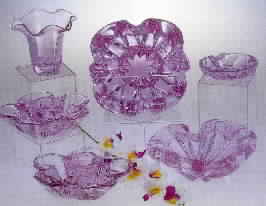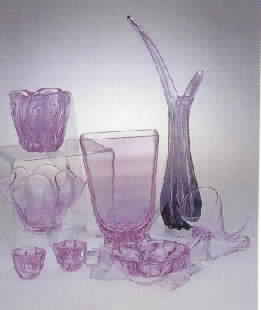|
|
|
|
|
|
|
|
|
|
|
|
|
 |
 |
 |
 |
 |
|
|
 |
|
|
|
 |
 |
 |
| Tiffin introduced its Twilight around 1951. Three of my reference sources indicate that even until Tiffin`s closing in 1980, some items were still being produced in Twilight. Tiffin also made a color called Twilite (note spelling) in the late 20s and early 30s. It was originally referred to as Evening Blue. This color does not have a dichroic nature. The similarity of the two names engenders confusion, as we might expect. Seen side-by-side, it is evident that the two are different, but when is anyone lucky enough to have that happen? As with all neodymium glass, the Twilight will change color and simplifies identification. Tiffin`s extraordinary art glass, made mostly during the 50s, rivals any art glass in the world. Forms, colors, dramatic sizes, and much free-hand inventiveness enliven this glass. Twilight was used in almost every line. "Dawn" was the name used for this glass, when it was used to produce items in molds that had been obtained by Tiffin when the Duncan Miller company closed. Items in the Canterbury line are frequently described as being in the Dawn color. Twilight and Dawn are the same glass formula. Tiffin also produced a color called Wistaria (note spelling). It is not dichroic and is more pink in color, but it is still confused with Twilight occasionally. |
 |
|
|
 |
 |
 |
|
|
|
 |
 |
 |
| It would be almost as easy to list the items which were not made in Twilight as it would be to list those which were, as this color was used for many lines and with dozens of individual item numbers. Items from the Empress line combine Twilight with Smoke or Green. The Empress line alone had about 75 shapes. By combining optics, hand-tooled foot variations, shapes and sizes, even a simple item, such as an ashtray, might have had fifteen or twenty different looks (and numbers.) There are pieces in Twilight with Bubble Optic, Swedish Optic (which was renamed Tiffin Optic after 1946), Spiral Optic (usually cornucopias), 5 Rib Optic, 10 Rib Optic, Bubble Ball stem, #17430 hand-applied four-part foot, Manzoni foot (example in photos), Cellini line (hand-tooled open-work stem), Scallop Edge, Blown foot, Bubble stem with teardrop and others. Twilight can be found in stems, vases, bowls, pitchers, nappies, candleholders, compotes, centerpieces, flower arrangers, hurricane lamps, candy boxes, creamer and sugar sets, bon bons, free-form decorative items, hostess plates, rose bowls, baskets, and numerous ashtrays. A few pieces were also engraved or cut. I can recommend the following two books for additional information on Tiffin`s Twilight: Tiffin Glassmasters The Modern Years by Kelly O`Kane and Tiffin Modern Mid-Century Art Glass by Ruth Hemminger, Ed Goshe and Leslie Pina. I can also show you the items in the photos, and you can see a sample of the beauty and versatility of Tiffin`s Twilight. |
|
 |
|
|
 |
 |
 |
 |
 |
 |
 |
|
 |
 |
 |
 |
|
|
|
 |
 |
 |
| Tiffin pieces Photo #10, clockwise from upper left: |
|
| (1) Canterbury vase (from Duncan and Miller mold.) 5". $35. |
| (2) #1 Ashtray. 4 ¼" in height and 8 ½" across. This piece weighs 5# $175. |
| (3) Cloverleaf ashtray. 4 ½". $35. |
| (4) #5453 Heart-shaped ashtray. 8". $125. |
| (5) & (6) Candlelight Garden Set. Two bowls with removable candle holders in centers. 7" width. $200. |
|
| The #1 ashtray and the #5453 ashtray are made from a10-rib optic. The glass is folded and pulled into these shapes. The whole upper edge of the heart-shaped piece is folded back on itself, and there are open spaces on the underside. These heavy pieces catch light and reflect it beautifully. |
|
 |
|
|
 |
 |
 |
 |
 |
 |
 |
 |
 |
|
 |
 |
 |
|
|
|
 |
 |
 |
| Tiffin pieces Photo #9, clockwise from upper left: |
|
| (1) #33 10-rib optic, square vase. 5 ¼". $225. |
| (2) #6559 Empress, 10 rib-optic, twilight and smoke vase. 20". $200. |
| (3) #5507 Cornucopia. 8". $120. |
| (4) Cloverleaf ashtray. 6 ½". $45. |
| (5) & (6) Two candle holder-inserts for Candlelight Garden. 2 ½". $85. |
| (7) Flower arranger-bowl (from Duncan Miller Canterbury mold.) 8" $50. |
| (8)(Center of photo) 10 ¼" Tiffin Optic #15 vase with Manzoni foot. |
|
| Until I found this one, I had only seen drawings and mentions of the 10 ¼" Tiffin Optic #15 vase with the Manzoni foot. It is a wonderful piece and the one selected for the front cover. This may be the first one in this size photographed for publication. |
|
 |
|
|
 |
 |
|
|
|
 |
 |
 |
| I hope neodymium glass is less of a mystery now. Whether this glass is used in a fantastic Moser piece from the 1920s or in a little Boyd carousel horse from the 1990s, the color delights, and its changeable nature intrigues. I am hoping there are other collectors who would like to share their experiences and discuss their collections. I end with a warning though. If you want to collect this glass, you will have to learn how to ask that page-long question from the beginning of this article and not run out of breath. |
|
 |
|
|
 |
 |
 |
 |
|
|
|
 |
 |
 |
| Judith Van Buskirk-Gugudan and her husband, Charles, recently moved from Hawaii to Florida for their retirement. They are interested in neodymium glass, art glass, EAPG canary/vaseline glass and glass identification. Judith is a member of Heisey Collectors of America, Inc., Tiffin Glass Collectors Club, Fostoria Glass Society of America, Inc., National Duncan Glass Society, Inc., National Cambridge Collectors, Inc., and Vaseline Glass Collectors, Inc. |
| E-mail address is gugudan@citrus.infi.net |
|
| Photos taken by Mr. Newton Harman, Springs Photo, Crystal River, |
| Florida. |
|
|
 |
|
|
 |
 |
 |
 |
 |
 |
 |
|
|

